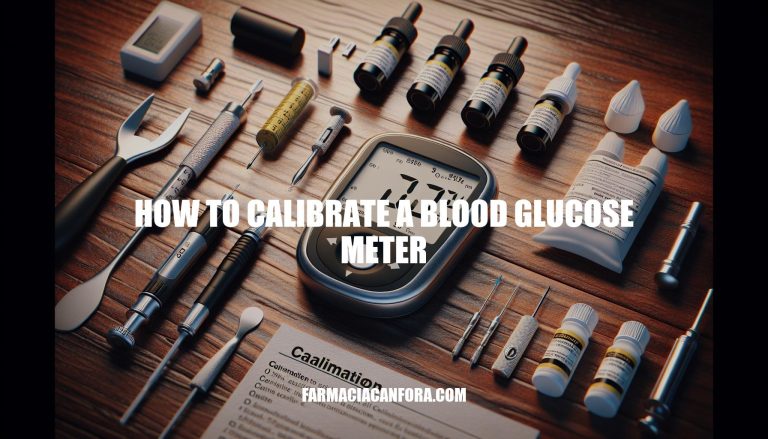Calibrating a blood glucose meter is crucial for ensuring accurate blood sugar readings. Accurate readings are essential for effective diabetes management, helping to make informed decisions about medication, diet, and lifestyle adjustments. Regular calibration helps maintain the reliability of the meter, preventing errors that could lead to incorrect insulin dosing or other serious health consequences.
Understanding Calibration
Calibration is the process of adjusting a blood glucose meter to ensure its readings are accurate. This involves setting the meter to match a known standard, often using a control solution or a specific code from the test strip.
Why it’s essential:
- Accuracy: Regular calibration ensures the meter provides correct blood sugar levels, which is crucial for managing diabetes effectively.
- Safety: Accurate readings help prevent dangerous highs or lows in blood sugar.
- Reliability: Consistent calibration maintains the meter’s reliability over time.
Steps to Calibrate a Blood Glucose Meter
Sure, here’s a step-by-step guide to calibrate a blood glucose meter:
Preparing the Meter
- Gather Supplies: Ensure you have the meter, test strips, control solution, and a clean, dry surface.
- Check Expiration Dates: Verify that the test strips and control solution are not expired.
- Insert Test Strip: Place a test strip into the meter to turn it on.
Using Control Solutions
- Shake Control Solution: Shake the control solution bottle well.
- Apply Control Solution: Squeeze a drop of the control solution onto a clean surface (not directly onto the strip). Touch the test strip to the drop.
- Wait for Results: The meter will display a reading after a few seconds.
Verifying the Results
- Compare Results: Check the reading against the control range printed on the test strip vial.
- Repeat if Necessary: If the reading is outside the range, repeat the test with a new strip and solution drop. If it still falls outside the range, consult the meter’s manual or contact customer support.
Final Steps
- Record Results: Note the results in your logbook or digital tracking tool.
- Store Supplies: Keep the meter, test strips, and control solution in a cool, dry place.
Following these steps ensures your blood glucose meter is accurately calibrated and ready for use.
Common Issues and Troubleshooting
Here are some common problems during the calibration of a blood glucose meter and how to troubleshoot them:
-
Error Messages:
- Problem: Meter displays an error message.
- Solution: Check the user manual for specific error codes. Ensure the test strip is properly inserted and compatible with your meter. Replace batteries if needed and use the monitor at room temperature.
-
Inaccurate Readings:
- Problem: Readings seem unusually high or low.
- Solution: Wash and dry hands thoroughly before testing. Ensure test strips and control solutions are not expired. Store test strips in a cool, dry place. Calibrate the meter as per the manufacturer’s instructions.
-
Insufficient Blood Sample:
- Problem: The meter indicates an insufficient blood sample.
- Solution: Warm hands to increase blood flow. Ensure the lancing device is set to an appropriate depth. Touch a generous drop of blood to the test strip.
-
Test Strip Issues:
- Problem: Damaged or outdated test strips.
- Solution: Discard damaged or expired test strips. Store strips in their sealed container away from moisture and humidity.
-
Monitor Problems:
- Problem: Monitor not functioning properly.
- Solution: Fully insert the test strip into the monitor. Replace the monitor batteries as needed. Replace the monitor every 4 to 5 years.
-
Environmental Factors:
- Problem: Extreme temperatures affecting readings.
- Solution: Keep your glucose meter and test strips at room temperature.
-
Calibration Timing:
- Problem: Calibrating during rapid blood glucose changes.
- Solution: Avoid calibrating when blood glucose levels are changing quickly, such as after eating, taking insulin, or exercising.
If you encounter persistent issues, consult the user manual or contact the manufacturer for further assistance.
Maintaining Calibration Accuracy
Here are some tips to maintain the accuracy of your blood glucose meter:
- Store Test Strips Properly: Keep them in their original container with the lid tightly closed. Avoid exposure to light, moisture, and extreme temperatures.
- Check Expiry Dates: Always use test strips before their expiration date.
- Clean the Meter Regularly: Follow the manufacturer’s instructions for cleaning.
- Perform Quality Control Checks: Use control solutions to test the meter’s accuracy periodically.
- Calibrate as Needed: Some meters require calibration with each new batch of test strips.
- Replace Batteries: Keep spare batteries on hand and replace them as needed.
- Avoid Contamination: Wash and dry your hands thoroughly before testing.
- Store at Room Temperature: Keep the meter and test strips at room temperature, avoiding extreme heat or cold.
These practices will help ensure your readings remain accurate over time.
Calibrating a Blood Glucose Meter: A Crucial Step in Diabetes Management
Calibrating a blood glucose meter is crucial for accurate readings, which are essential for effective diabetes management. Regular calibration ensures the meter’s reliability over time and prevents errors that could lead to incorrect insulin dosing or serious health consequences.
Steps to Calibrate a Blood Glucose Meter
- Gather supplies
- Check expiration dates
- Insert test strip
- Shake control solution
- Apply control solution
- Wait for results
- Compare results
- Repeat if necessary
- Record results
- Store supplies
Troubleshooting Common Issues During Calibration
- Error messages
- Inaccurate readings
- Insufficient blood sample
- Test strip issues
- Monitor problems
- Environmental factors
- Calibration timing
Maintaining Accuracy and Preventing Errors
- Store test strips properly
- Check expiry dates
- Clean the meter regularly
- Perform quality control checks
- Calibrate as needed
- Replace batteries
- Avoid contamination
- Store at room temperature


